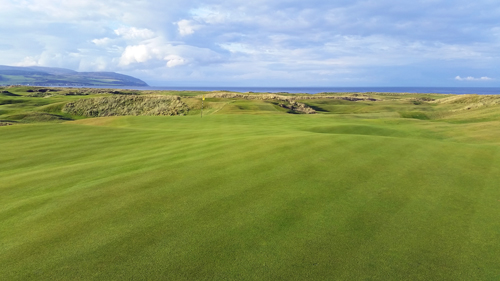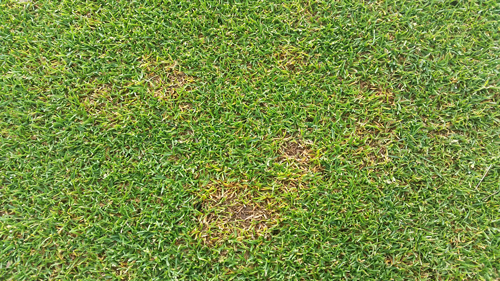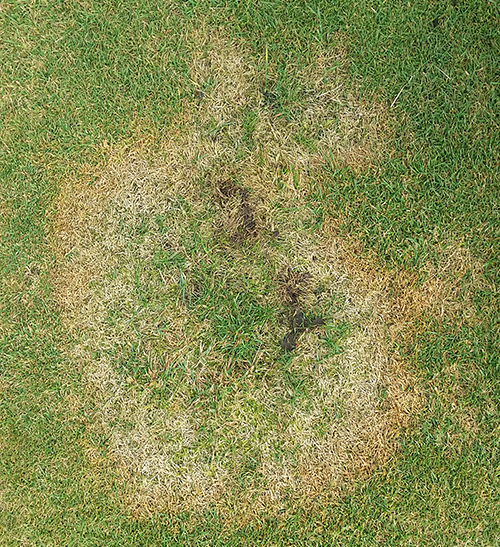Our monthly golf course update from our Head Greenkeeper, Simon Freeman:
Course Conditions Update
September was widely and quite rightly lauded as an outstanding month weather-wise across the whole of the United Kingdom, and we at Machrihanish Dunes certainly welcomed the brilliant golfing and working conditions that this late summer sunshine brought with it. As you all know, golfing calendars are set to favour play during the months that are “traditionally” more favourable weather-wise, so a spell of reasonably warm, dry weather so late in the year, coupled with shorter days and heavy dews, allowed us to undertake a lot of overseeding and minimalist aeration work which will stand us in good stead going into winter. Those of you who played in the Autumn Pairs event on 11th October would likely agree that the course was in superb health as you can see from the striking image below taken during the event.
 The golf course looked fantastic at the Autumn Pairs Tournament!
The golf course looked fantastic at the Autumn Pairs Tournament!
Always be Prepared
Over the next few months, our priority is to protect the density of grass cover on our playing surfaces (especially on the greens and tees), an initiative we’ve had on our mind for a few months now. In a location as exposed as Machrihanish, any gaps in the sward (even one as small as a pitchmark) will be exposed by a gale in a matter of hours, and can easily become a dinner-plate-sized bare patch in just a few wild days. As greenkeepers, we will do everything in our power to minimise the defects, ensuring that the progress of the salt-laden wind is not interrupted as it whistles smoothly over the grass. Our main enemies are turf disease (which can kill grass and leave small bare patches which the wind can get into and dramatically extend) and scalping from machinery. So we raise the mowers substantially at this time of year to retain a larger surface of leaf to allow the plants to photosynthesise more effectively during periods where there are typically fewer hours of sunshine, a feature of the West Coast, but also to ensure that we avoid making bare patches through mechanical damage.
Combating Turf Disease
Controlling turf disease is another one of those classic catch-22 dilemmas that tend to scramble the brain of the turf manager. It is widely known from historical experimentation that over-use of fungicides to control disease in poorly-managed greens will ultimately lead us into a spiral of decline. Therefore, a balance must be found between implementing a rounded management regime that helps the turf to fight off fungal infection, and also applying the most suitable products if and when the pressure of disease becomes too great and remedial spraying becomes a necessity.
At Machrihanish Dunes, we are blessed with free-draining rootzones that have not built up a massive layer of surface organic matter (disease thrives in conditions where the top 20mm of the soil suffers from a lack of oxygen and is contaminated with decaying leaf matter).
We cannot afford to rest on our laurels though, which is why we:
- regularly aerate the surface to ensure air flow and gas exchange can occur without being hampered by surface compaction
- topdress regularly with a sandy material to dilute any surface build-up of debris and decaying matter
- stick to an agreed feeding program that has both short-term and long-term beneficial implications for the health of our turf
- constantly monitor heights of cut to ensure that we do not compromise the well-being of individual plants.
If we ignore any of these and the many other important processes, plants will get sick, thatch will build up, disease will occur more regularly, bare patches will appear, and the wind will find its way into the gaps and literally tear the grass off the greens.
 Fusarium Patch in a Machrihanish Dunes green. Fusarium is the most problematic pathogen for Greenkeepers.
Fusarium Patch in a Machrihanish Dunes green. Fusarium is the most problematic pathogen for Greenkeepers.
When faced with one of these catch-22 dilemmas, I always relate the health of the grass on our fine turf surfaces with the health of my own body. I know that if I stay fit, eat right, get plenty of sleep and avoid stress, I will be far less likely to succumb to infection. The same set of rules can be applied when looking after turfgrass – if we aerate regularly, keep surface thatch under control, apply the right nutrients in the right quantities and allow the greens to recover from periods of stress by raising heights of cut as and when required, we should be able to keep disease and other associated issues at bay without resorting to the medicine cabinet!
 Take-All Patch. It is fairly slow-moving and leaves the fescue unaffected.
Take-All Patch. It is fairly slow-moving and leaves the fescue unaffected.
If you have any questions about any of this or would simply like to know more about the work we do, feel free to come over and ask anytime. Even though the days are getting shorter, we hope to still see you out enjoying your golf over the winter months!
Sincerely,
Simon Freeman
Head Greenkeeper

